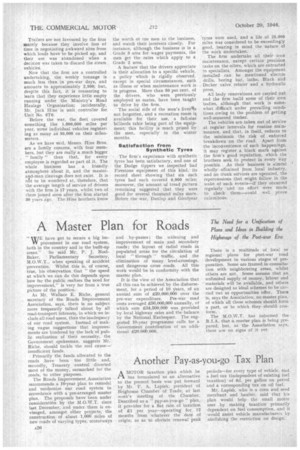A Master Plan for Roads
Page 28

If you've noticed an error in this article please click here to report it so we can fix it.
" WJE have got to secure a big im VV provernent in our road system, both in the country and in the built-up areas." So said Mr. P. J. NoelBaker, Parliamentary Secretary, M.O.W.T., when speaking of accident prevention. Whilst this is, of course, true, his observation that " the speed at which we can do this depends upon how far the public realizes the need for improvement," is very far from a true picture of the position.
As Mr. Wallace E. Riche, general secretary of the Roads Improvement Association, says, there is no subject more frequently talked about by all road-transport interests, in which we include all road users, than the inadequacy of our road system. Instead of making vague suggestions that improvements are hindered by the lack of public realization of their necessity, the Government ,spokesman, suggests Mr. Riche. should tackle the real cause— insufficient funds.
Primarily the funds allocated to the roads have been too little and, secondly, Treasury control diverted most of the money, earmarked for the roads, to other purposes.
The Roads Improvement Association recommends a 10-year plan to remodel and modernize our road system in accordance with a pre-arranged master plan. The proposals have been under consideration by the M.O.W.T. since last December, and under. them is envisaged, amongst Other projects, the construction of about 1,000 miles of new roads of varying types, motorways
and by-passes ; the widening and improvement of main and secondary roads ; the layout of radial roads in populated .areas for the circulation of local " through " traffic, and the elimination of many level-crossings, and, dangerous cross roads, All this work would be in conformity with the master plan.
It is the view of the Association that all this can be achieved by the disbursement, for a period of 10 years, of an annual sum of 40,000,000 over the pre-war expenditure. Pre-war road costs averaged R.56,000,000 annually, of which sum £34,500,000 was provided by local highway rates and the balance by the National Exchequer. The suggested 10-year programme calls for a Government Contribution of an additional £20 ,00h , 000
There is a multitude of local or regional plans for post-war road development in various stages of preparation. Some are framed in consultation with neighbouring areas, whilst others are not. Some assume that an, unlimited supply of money, labour and materials will be available, and others are designed as ideal schemes to be carried out as opportunities offer. There is, says the Association, no master plan, of which all these schemes should form a part, or to which they should conform.
The M.O.W.T. has infortned the R.I.A. that amaster plan is being prepared, but, as the Association says, there are no signs of it yet




















































